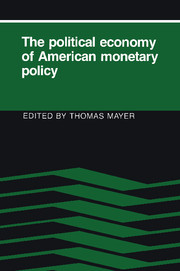Book contents
- Frontmatter
- Contents
- Preface
- List of contributors
- 1 Introduction
- 2 Studying the Fed: toward a broader public-choice perspective
- 3 The Federal Reserve reaction function: a specification search
- 4 Corporate profitability as a determinant of restrictive monetary policy: estimates for the postwar United States
- 5 Federal Reserve behavior since 1980: a financial-market perspective
- 6 The Federal Reserve and its institutional environment: a review
- 7 The political economy of monetary policy
- 8 Political monetary cycles
- 9 Congress and the Fed: why the dog does not bark in the night
- 10 The Federal Reserve as a political power
- 11 Monetary policy and political economy: the Federal Reserve and the Bank of Japan
- 12 A positive analysis of the policy-making process at the Federal Reserve
- 13 A theory of FOMC dissent voting with evidence from the time series
- 14 Explaining FOMC members' votes
- 15 Fed behavior and X-efficiency theory: toward a general framework
- 16 Minimizing regret: cognitive dissonance as an explanation of FOMC behavior
- 17 The discount window
- 18 Leaning against the wind: the behavior of the money stock in recession and recovery, 1953–8
- 19 Bureaucratic self-interest as an obstacle to monetary reform
- Index
15 - Fed behavior and X-efficiency theory: toward a general framework
Published online by Cambridge University Press: 06 July 2010
- Frontmatter
- Contents
- Preface
- List of contributors
- 1 Introduction
- 2 Studying the Fed: toward a broader public-choice perspective
- 3 The Federal Reserve reaction function: a specification search
- 4 Corporate profitability as a determinant of restrictive monetary policy: estimates for the postwar United States
- 5 Federal Reserve behavior since 1980: a financial-market perspective
- 6 The Federal Reserve and its institutional environment: a review
- 7 The political economy of monetary policy
- 8 Political monetary cycles
- 9 Congress and the Fed: why the dog does not bark in the night
- 10 The Federal Reserve as a political power
- 11 Monetary policy and political economy: the Federal Reserve and the Bank of Japan
- 12 A positive analysis of the policy-making process at the Federal Reserve
- 13 A theory of FOMC dissent voting with evidence from the time series
- 14 Explaining FOMC members' votes
- 15 Fed behavior and X-efficiency theory: toward a general framework
- 16 Minimizing regret: cognitive dissonance as an explanation of FOMC behavior
- 17 The discount window
- 18 Leaning against the wind: the behavior of the money stock in recession and recovery, 1953–8
- 19 Bureaucratic self-interest as an obstacle to monetary reform
- Index
Summary
In this chapter a conceptual framework developed from the insights of X-efficiency (XE) theory is employed to analyze the behavior and performance of the Fed. Our analysis makes two major points of departure. First, the extreme public-choice and neoclassical perspectives are regarded as limiting cases. In our framework, the Fed attempts to strike a trade-off between (1) increasing its own organizational welfare (publicchoice perspective) and (2) increasing public welfare (neoclassical perspective). Second, from the perspective of XE theory, we regard completely optimal behavior by the Fed as a limiting case, because this perspective allows for the existence of behavior that is less than completely optimal behavior, or X-inefficient behavior. However, this contention does not imply that Fed policy-makers are selfish or incompetent. X-inefficiency is a ubiquitous phenomenon that exists (at least to some degree) in almost all organizations, in spite of best intentions and vigilance. The precise extent of X-inefficiency in an organization may be controversial. Its potential existence should not be ruled out on a priori grounds.
Ideally, this assertion should be backed by numerous examples of Xinefficiency in the Fed. However, because there is always considerable controversy about the precise optimal monetary response in a specific situation, it is difficult to assert with certainty that a given Fed response or behavior is X-inefficient. Janis and Mann (1977) concede that within an organization, frequently it is impossible to carry out adequately controlled field experiments that permit unambiguous determination of the causal impact of alternative decision-making styles and procedures. Our problem is even more intractable because the responses themselves are controversial.
- Type
- Chapter
- Information
- The Political Economy of American Monetary Policy , pp. 227 - 238Publisher: Cambridge University PressPrint publication year: 1990



